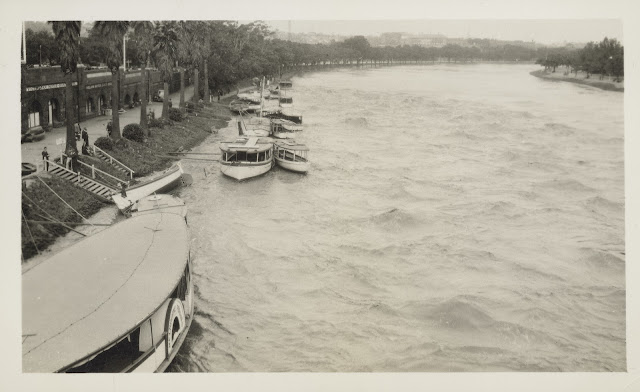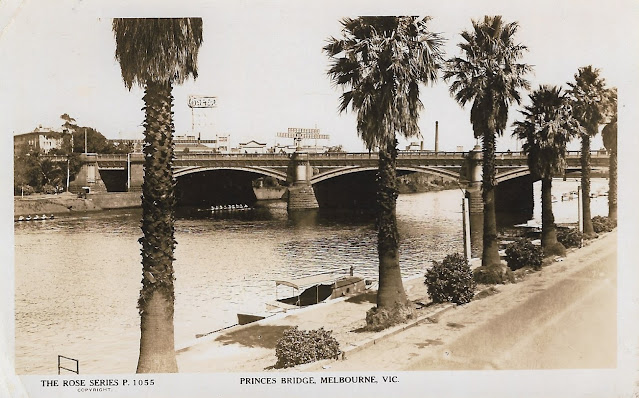At one stage Carlo Catani was considered the most likely candidate for the Chairmanship of the CRB. Punch reported in October 1912 that The Chairman of the Main Roads Board is to receive £800 a year. He will almost certainly be Mr. Catani, who has been thinking out the engineering problems of the Public Works Department for many years, and yet gets only £650 a year, a remuneration which the average successful engineer in private practice would scorn (7). The Bendigo Independent reported in December of that year that When the bill was first introduced Mr C. Catani, Chief Engineer of Public Works, was accepted as almost a "certainty" for the position of chairman of the board. Under the new State reclassification scheme Mr. Catani's position will be so improved that it is just possible he may prefer to remain with the Public Works Department (8). However in January 1913, Punch reported that Carlo had declined to leave his present position (9).
Photo of Carlo - Chairman of the Motor Traffic Committee
(or the committee which has suggested new regulations as The Herald says)
The Herald May 22, 1916 https://trove.nla.gov.au/newspaper/article/242328115
Continuing his career in the Public Works Department did not stop Carlo's involvement with roads and roads maintenance as in February 1916 the Minister of Public Works, W. A. Adamson (10) appointed him as Chairman of the newly created Motor Traffic Committee. The purpose of the committee was to suggest legislation [to deal] with the problem of alleged destruction of roads by motor traffic (11). The other members of the Committee were William Calder and Frederick Fricke of the CRB and A.T. Clark (12), Public Works Department Engineer of Roads and Bridges.
The Victorian Year Books (13) give us some interesting statistics about the increasing popularity of motorised vehicles. On June 30, 1912 there were 3,944 motor cars registered and 2,784 motor cycles; on December 31, 1916 - 10,713 motor cars and 8,123 motor cycles; and on December 31, 1918 - 15,158 motor cars and 9,928 motor cycles, so even the War didn't dint the enthusiasm for motor vehicle ownership, and thus it was not surprising that roads designed for horse traffic were not coping with more traffic and heavier vehicles.
The Committee reported back to Mr Adamson a few months later in May 1916 and recommended that legislation be enacted to (a) to protect roads from damage by the unrestricted use of heavy motor vehicles, and to require owners of vehicles to contribute toward the cost of special contribution and maintenance necessary for the case of traffic; (b) to protect roads from injury by excessive speed of heavy and light motor vehicle; and (c) to require large contribution to the fund for main road maintenance from users of motor cycles and motor cycles with side car attachment (14).
The Automobile Club (15) objected to the speed restrictions of commercial vehicles and argued that roads should be built to suit the traffic and allow produce to be transported at the fastest speed at which a mechanically propelled vehicle can travel. The Motor Committee said that if this was done it would cost the state £344,205,000 (16). At the time Victoria had 68,841 miles of roads - that's about 111,000 kilometres (17).
As a matter of interest it was recommended that the speed of heavy vehicles be restricted to eight miles per hour, but they could travel on any road. If the heavy vehicles were restricted to particular routes then the speed limit could be increased to ten miles per hour (18). The Automobile Club also suggested that as a way to raise extra revenue for road maintenance all horses in Victoria should be taxed as it was ridiculous to assert that the 10,000 motor vehicles of all descriptions had caused more damage than the 562,321 untaxed horses (19).
The Motor Traffic Act was debated in the Victorian Parliament in November and December 1918, I am unsure if it was passed. The Parliamentary debate included Mr Bayles (20) arguing that iron wheels and horses' feet were more destructive to road surfaces than motor cars; Mr Weaver (21) arguing that vehicles should be taxed on weight and not horse-power and Mr Prendergast (22) arguing that a distinction should be made between those who used motor vehicles for commercial purposes and those who used them for pleasure (23).
Carlo had an obvious interest in roads and road maintenance both from an engineering viewpoint and from the value that good roads had in opening up areas for farming and tourism. He knew that they also improved the amenity of people living in country areas by giving them better access to markets, shops, education and social activities. He was especially sensitive to the isolation of women in rural areas - It was not right to keep women in this back country unless they had proper road communication. The woman had to bear children. She was doctor, mother, teacher, everything, in this part of the world, and for her sake alone it was the duty of Governments to provide roads to enable her to get in and out. She was entitled to the same rights and privileges as the ordinary civilised being. These she could not have without decent means of communication (24).
The Victorian Year Books also have statistics on the number of people who were licensed by the Chief Commissioner to drive a motor vehicle. In 1912 there were 8,467 licenses; 1916 - 21,634 and 1918 - 27,423. I wondered whether Carlo had a licence and drove a motor car. There are many articles in the newspapers where he is driven, or 'motored', to various locations, often with politicians such as the Minister for Public Works, who I would assume had a government car and driver; or with other public servants or local councillors. I haven't come across any references to Carlo specifically being the driver, but I feel that with his interest in machinery, technology and new innovations that he would almost certainly have learnt to drive a car. Did he own a car? There was not a car listed in his assets in his Probate papers, so it doesn't appear that the Catani family owned a car (25).
Trove List
I have created a list of articles on Trove related to the Motor Traffic Committee and the suggestion that Carlo's would be appointed as the first Chairman of the CRB, access the list here.
Notes
(1) Lay, Max Melbourne Miles: the story of Melbourne's Roads (Australian Scholarly Publishing, 2003) p. 46.
(2) Country Roads Board Victoria 1913-1963: Fifty Years of Progress (CRB, 1963), p. 14. There is also a history of the early days of the CRB in Roads for the People: a history of Victoria's Roads by W.K. Anderson (Hyland House, 1994).
(3) William Davidson, Inspector General of Public Works. Mr Davidson retired in 1912, you can read an interesting account of his life, here, in The Argus of August 24, 1912. He died September 2, 1920 aged 75.
(4) William Calder (1860-1928) - the namesake of the Calder Highway. Read his entry in the Australian Dictionary of Biography, here.
(5) William Thomas Bartholomew McCormack - before he was appointed to the CRB he was an engineer with the Public Works Department. After William Calder's death he was appointed as the Chairman of the CRB. He died on January 22, 1938 aged 59. Read his short obituary, here, in the The Argus of January 24, 1938. Mr McCormack was the honorary engineer of the Great Ocean Road Trust and a Memorial Arch and Tablet was unveiled in his honour in November 1939, read about this here.
(6) Frederick William Fricke, became Chairman of the CRB after Mr McCormack's death. He had previously been with the Lands Department and retired from the CRB in 1940. Frederick's brother, Frederick Thomas Allan Fricke (they really were both called Frederick) was the Secretary for Lands. Frederick William died December 15, 1949 aged 79, read his obituary here.
(7) Punch October 24, 1912, see here.
(8) Bendigo Independent December 25, 1912, see here.
(9) Punch, January 2, 1913, see here.
(10) William Addison Adamson (1858 - 1924). Read about him here on the Victorian Parliament website - Re-Member Former Members.
(11) The Age July 11, 1916, see here.
(12) Alfred Thomas Clark. Appointed Assistant Engineer, Public Works Department Roads, Bridges and Harbours in October 1909 (Victorian Government Gazette October 20, 1909). Appointed as a member of the St Kilda Foreshore Committee to replace Carlo Catani in August 1918 (see here). His wife Evelyn Annie Clark instituted divorce proceedings against him in 1920 (the file is at the PROV). This seems to have been the start of a decline in his behaviour, in 1923 he was charged with having obstructed the footpath in Elizabeth Street (see here) - must be more to that story than was reported. In July 1928 he was charged with drink driving (see here) and a month later was the subject of a Public Service Inquiry due to alleged misconduct under the provisions of the Public Service Act (see here). The verdict of the Inquiry was not proved (see here). Perhaps connected to this, his services were Dispensed with (Victorian Government Gazette August 27, 1930). However, unless there were two A.T. Clarks, both Public Works Department engineers, there are still reports in the newspapers of Alfred working with the Public Works Department after this date (such as here), so perhaps he was reinstated. I believe his final position was as Shire Engineer at Warracknabeal (see here). He died December 19, 1949, aged 69.
(13) Victorian Year Books are digitised from 1973 - 2002, access them on the State Library of Victoria website https://guides.slv.vic.gov.au/vicgovpubs/yearbooks
(14) The Age September 7, 1916, see here.
(15) Automobile Club of Victoria, now the Royal Automobile Club of Victoria. For a history read The Crown of the Road: the story of the RACV by Susan Priestley (Macmillan, 1983)
(16) The Herald September 11, 1916, see here.
(17) The Age September 7, 1916, see here.
(18) The Herald September 11, 1916, see here.
(19) The Age September 7, 1916, see here.
(20) Norman Bayles (1865 - 1946) Read about him here on the Victorian Parliament website - Re-Member Former Members.
(21) Isaac Job Weaver (1869 - 1954) Read about him here on the Victorian Parliament website - Re-Member Former Members.
(22) George Michael Prendergast (1854 - 1937) Read about him here on the Victorian Parliament website - Re-Member Former Members.
(23) The Argus, December 5, 1918, see here.
(24) Weekly Times, June 1 1912, see here.
(25) Probate papers at the Public Records Office of Victoria.


































